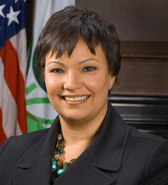Chemical Reform
Air Date: Week of October 9, 2009

Lisa Jackson is administrator of the Environmental Protection Agency. (Courtesy of EPA)
For 30 years, EPA has been forced to rely on industry to police itself to protect the public from hazardous chemicals. Now, the agency aims to re-invent the Toxic Substances Control Act, or TOSCA, to give EPA greater regulating authority. Host Jeff Young talks with Dr. Megan Schwarzman from UC Berkley about what effect the suggested reforms might have on international commerce, public health, and green chemistry innovation.
Transcript
YOUNG: It’s Living on Earth, I’m Jeff Young. We’ve reported a lot lately on BPA in plastics, the weed killer Atrazine, and the rocket fuel ingredient perchlorate – chemicals raising health concerns and building up in our environment despite a law intended to prevent that. Now, the Environmental Protection Agency’s administrator Lisa Jackson says the 30-year old law governing toxic chemicals is inadequate to protect the public.
She wants Congress to reform TOSCA – the Toxic Substances Control Act – to give her agency authority to move more quickly when scientists find health risks. Dr. Megan Schwarzman studies environmental health at the University of California, Berkeley. She coauthored a paper this summer titled “Toward a New U.S. Chemicals Policy”. Dr. Schwarzman, is that where we’re headed here, toward a new policy?
SCHWARZMAN: I really think it is. This is the first time in a generation that we’re really seeing this as an actual probability, in fact, a certainty, and there are several things that have led us in that direction, but this announcement by administrator Jackson indicating the administration’s will and goals for chemicals management for the country is truly significant.
YOUNG: Give us a sense of what EPA has been able to do under TOSCA, the existing law – what kind of progress have they made toward really regulating chemicals?
SCHWARZMAN: Well, it’s been over 30 years since TOSCA was passed, and in that time EPA has issued formal rules to restrict the use of only five chemicals, so that in itself when you’re comparing five to the universe of approximately 80,000 chemicals that are understood to be in use in the US, that’s a tremendously small number of substances that EPA has been able to act on and it makes you wonder whether they really have the tools they need to do their job.
YOUNG: Why is it that the current system does not allow EPA to make those priorities about what is or isn’t of chief concern?
SCHWARZMAN: To make priorities you have to have information, so to decide that one hazard is worse that another, to decide that benzene is worse than formaldehyde or is worse than asbestos, you need to know information about what exactly those hazards are. And basically, EPA has been denied that information. Without that information, they can’t set priorities and can’t determine what first needs to be acted on. The second thing that they lack is tools. So, they lack the information and they also lack the authority to require more information or to take action. They’re required to meet a burden of proof that is so high that they virtually can’t meet it.

Megan Schwarzman
YOUNG: You know, another complaint that we’ve heard a lot of on this program from scientists who are looking into health concerns of different toxics chemicals is that everything is kind of done assuming a standard human, but there’s a little attention paid to people who might be more sensitive to the given health risks. Is that something that the EPA would take into account with these changes being proposed here?
SCHWARZMAN: These proposed changes do make a very significant statement that the first ever about the obligation to assess risks to sensitive sub-populations. And what we generally understand those to be are children, workers who tend to be exposed to higher amounts of chemicals than the average person, to communities who are disproportionately affected, those who live near toxic waste sites or what we call “fence line” communities, also extending it to women of child-bearing age, that’s a very sensitive population in terms of what the implications are of chemical exposures.
YOUNG: Now, in 2006, the European Union changed the way it does chemical regulation to something called REACH. How’s that affected what might happen here in the US?
SCHWARZMAN: It’s affected it tremendously. One thing that it does is make change here almost inevitable because one this that REACH does is it applies equally to European and foreign producers of chemicals. If you want to sell your product in Europe, you have to meet these requirements, and these requirements mean that you have to provide information about that chemical to the European chemicals agency that based on the volume of the chemical that you import or produce you have to provide increasing amounts of data. So, in fact, US companies who are not subject to those kind of requirements in the US are having to come into compliance with them to continue access to the world’s largest market, which is Europe.
YOUNG: I know a lot of people in the industry are moving toward, or are at least interested in moving toward, what’s called green chemistry, where they design products, you end up with a less toxic product or less pollution in the process. Does the current regulatory system encourage that, would these proposed changes encourage more of that?

Lisa Jackson is administrator of the Environmental Protection Agency. (Courtesy of EPA)
SCHWARZMAN: Currently, in the US, though we don’t have a lot of data requirements for introducing new chemicals, there are more data requirements for introducing a new chemical than for an old chemical, and that produces this sort of perverse incentive, it’s backwards – so that to do something innovative and to bring a new product to market, you actually have to provide information, than just using the same old product, and that really stifles innovation. I think these proposed changes are exactly what we need to encourage the innovation towards safer substances. That is green chemistry is this process of designing out the hazard of chemicals from the beginning.
We’ve clearly failed at mopping up the mess we make. The resources are overwhelmed, and these hazards have proved uncontainable, and so moving back upstream and sort of creating things that are sort of benign by design, as they say, seems really the only sustainable solution. So, the proposals for what new chemicals management should look like that came out of the EPA will go a long way, if they’re implemented, toward advancing that.
YOUNG: Dr. Megan Schwarzman is research scientist in Environmental Health Sciences at the University of California’s School of Public Health. Thanks for your time.
SCHWARZMAN: Thanks so much.
YOUNG: Now getting the chemicals law updated depends on Congress – we’ll keep you posted on that. For some of our reports on the chemicals of concern – go to our website, LOE dot ORG.
Links
Click here for Dr. Schwarzman’s paper, “Toward a New U.S. Chemicals Policy”
Click Here for LOE “Story BPA Update”
LOE Story “Low Dose Makes the Poison”
LOE Story “War of the Sciences”
LOE Story “EPA’s Chemical Delay”
Living on Earth wants to hear from you!
Living on Earth
62 Calef Highway, Suite 212
Lee, NH 03861
Telephone: 617-287-4121
E-mail: comments@loe.org
Newsletter [Click here]
Donate to Living on Earth!
Living on Earth is an independent media program and relies entirely on contributions from listeners and institutions supporting public service. Please donate now to preserve an independent environmental voice.
NewsletterLiving on Earth offers a weekly delivery of the show's rundown to your mailbox. Sign up for our newsletter today!
 Sailors For The Sea: Be the change you want to sea.
Sailors For The Sea: Be the change you want to sea.
 The Grantham Foundation for the Protection of the Environment: Committed to protecting and improving the health of the global environment.
The Grantham Foundation for the Protection of the Environment: Committed to protecting and improving the health of the global environment.
 Contribute to Living on Earth and receive, as our gift to you, an archival print of one of Mark Seth Lender's extraordinary wildlife photographs. Follow the link to see Mark's current collection of photographs.
Contribute to Living on Earth and receive, as our gift to you, an archival print of one of Mark Seth Lender's extraordinary wildlife photographs. Follow the link to see Mark's current collection of photographs.
 Buy a signed copy of Mark Seth Lender's book Smeagull the Seagull & support Living on Earth
Buy a signed copy of Mark Seth Lender's book Smeagull the Seagull & support Living on Earth

